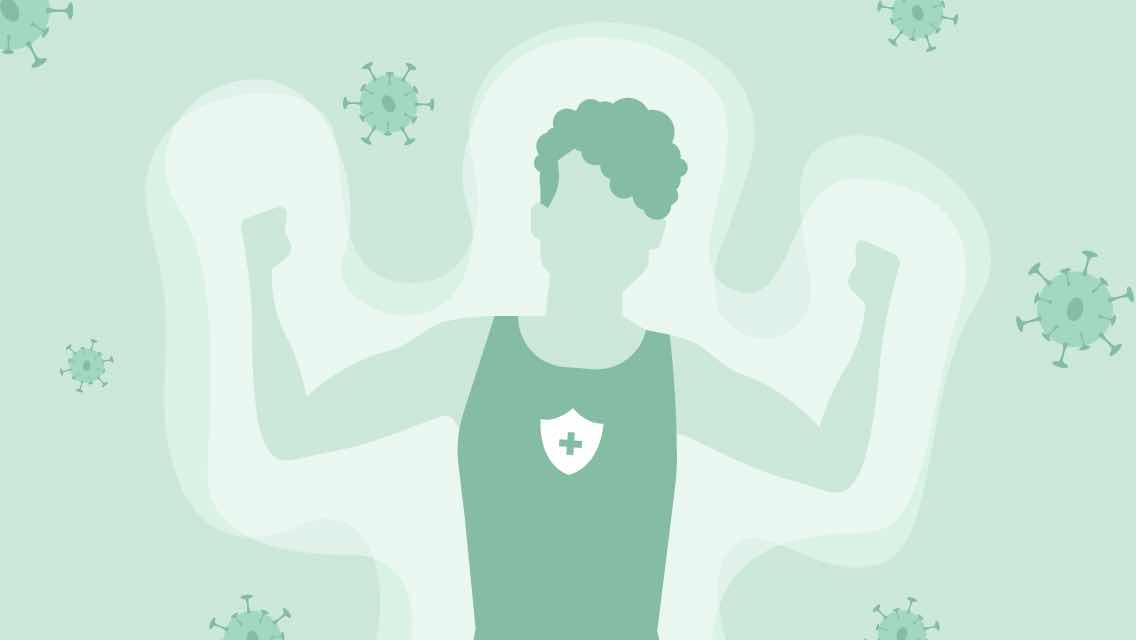“Knowledge is power.” Now more than ever, this phrase rings true in terms of achieving and maintaining good health. Given the current events, it’s becoming increasingly clear that our resilience in times of stress, sickness, and trauma is largely influenced by our day-to-day choices and health status. Staying healthy has become a front-of-mind priority for the general public, and getting blood tests for the immune system is becoming more commonplace.
If you’ve been following Life Time Training for any length of time, you know that our standard of good health is much more robust than simply not being sick, not meeting official diagnostic criteria, or otherwise being just “fine.”
Instead, we aim for a goal of peak vitality, performance, and potential — and we believe that each person deserves optimal health. Part of this process is regularly testing and assessing with objective data to better understand health, and this includes blood tests for a healthy immune system.
Great health is innately supportive of a healthy, balanced immune system. Balance is key. A suppressed immune system can increase the risk of infections, while an overactive and malfunctioning immune system can result in autoimmune diseases, such as Hashimoto’s, lupus, rheumatoid arthritis, and multiple sclerosis.
In autoimmunity, the immune system attacks healthy tissues. Autoimmune disorders are on the rise, likely due to various environmental and lifestyle changes over the past several decades.
While recovering from an accident, beating an infection, and successfully navigating through a health crisis can never be 100-percent guaranteed, there are key barometers of health that warrant monitoring every six to 12 months at a minimum. Getting the right tests done is step one. Step two is actually knowing and understanding your numbers.
Unfortunately, the attitude with reporting test results is often “no news is good news” and leaves much to be desired.
A healthier system is a more resilient system, and optimizing any potential trouble spots using both medical advice and lifestyle changes can serve you well in the long run. You owe it to yourself to get familiar with these markers of a healthy immune system.
Vitamin D
Knowing and optimizing vitamin-D status should be considered a no-brainer when it comes to supporting overall health and immunity. Links between vitamin-D status and physical and mental health seem to finally be getting some well-deserved mainstream recognition.
This fat-soluble vitamin is actually considered a pro-hormone, which means it can be thoughts of as a raw material needed to make other hormones, such as sex hormones, DHEA, and cortisol. It’s involved not only in bone health, mood, inflammation, nervous system, and muscle function, but is also a star player in the resilience of our immune system.
Adequate vitamin D can help fight off invaders while also supporting an overall healthy inflammatory response, which is important during times of active infection.
Unfortunately, vitamin-D deficiency is one of the most prevalent deficiencies in North America, with more than two in five Americans being overtly deficient, and many more having suboptimal levels. Like many blood markers, if you’re told by your physician that it’s out of range, chances are that your levels have been drifting outside of optimal and in the wrong direction for quite some time.
In my experience with clients and with reviewing thousands of sets of client lab data, most people who are not supplementing with vitamin D (and who do not live near the equator) have levels well below the optimal functioning range.
According to the Vitamin D Council, a range of 40 ng/mL (or 100 nmol/L) is the bottom rung of the ladder to be considered “sufficient.” Traditional reference ranges levels from labs have a lower cutoff that is roughly half of that level, or 20 ng/mL (or 50 nm/mL).
Sun exposure is one of the best ways to increase active vitamin-D levels in the body, but our modern lifestyle tends to keep most of us indoors for much of the day. Our vitamin-D production when we do get a chance to be in the sun is often blocked through the skin with the use of sunscreen.
While certain foods such as fatty fish, liver, and egg yolks provide some vitamin D, most people need to take 5,000 to 10,000 IU of the active form of vitamin D, called “cholecalciferol” (or vitamin D3) to achieve optimal blood levels. It’s better when combined with vitamin K2 and from a quality brand, such as Life Time’s, that also does not use lactose or other cheap ingredients to dilute it the way most over the counter options do.
(Heads up: Companies that use lactose to dilute are not required to disclose this on the label.)
Note that because vitamin D is fat-soluble, it is possible to over-supplement. Toxic levels of vitamin D are pretty rare and can be easily avoided with regular testing.
Bottom line? Get your levels tested one to two times per year and supplement accordingly. Here is more information on vitamin D if you’d like to dive deeper.
Blood Sugar
When talking about blood sugar, it’s easy to have a false sense of security if you’re not diabetic. However, the road to an official diabetes label (type 2 diabetes, specifically) can take decades — and the seemingly small, insidious, and incremental steps to getting there have far-reaching negative health consequences. In fact, more than one in 10 U.S. adults have diabetes, and over one-third have prediabetes. The scariest part? Less than half are aware of it.
In the general population, poor blood-sugar regulation is one of the most commonly observed metabolic imbalances.
Symptoms of poor blood-sugar control can include:
- Food cravings
- Trouble sleeping
- Energy fluctuations
- Feeling “hangry” — or short-tempered, shaky, or headaches between meals
- Belly fat
Sound familiar?
Here’s a quick run-down: When we consume foods, they’re broken down and absorbed in the digestive tract. While fats and proteins (unless grossly over-consumed) have a minimal impact on blood sugar, excess carbohydrates — especially in the context of insufficient fiber intake — can cause a blood-sugar roller coaster. However, what the body actually wants is a gentle, controlled, oscillating wave.
When blood sugar increases, your pancreas releases insulin to lower it by either moving it out of the blood and into your cells for energy production (particularly if you’re active and have a lot of muscle) or into fat storage.
It’s also worth noting that your sleep quality and quantity, stress levels, body composition, vitamin D and magnesium status, and exercise habits can all influence your ability to appropriately regulate blood sugar.
When blood-sugar levels are imbalanced, it’s harder to fight off infections, heal wounds, balance hormones, and manage inflammation.
There are several markers that can help provide a greater understanding of your blood sugar control:
- Fasting blood-sugar trend: Optimally, blood sugars in the 80 to 90 mg/dL are most desirable. However, you may be told you are “fine” with any value less than 100 mg/dL. In some cases, there is not concern raised until values are at or above 126 mg/dL, which is used as the cutoff diagnostic point for diabetes.
- Insulin (or the surrogate marker of insulin, C-peptide): This hormone is released when blood sugar increases. Conventional reference ranges for insulin can surge up to 25 mIU/L and still be considered normal. Many functional-health practitioners, however, target values of less than 10 mIU/L.
- Hemoglobin A1C: This blood test helps estimate your blood-sugar control over the previous three months. Measured as a percentage, a solid target is less maintaining a level that is than 5.3 percent, with most conventional ranges considering any value below 5.7 percent as normal.
If you’ve had any of the above markers checked and learned that your levels are not at optimal targets, many lifestyle factors can have a remarkably big impact. These include staying physically active (especially with weight training), prioritizing protein along with vegetables and fruits, and making a few swaps to the meals you already eating.
If you have not had the markers tested, work with your doctor to get them assessed. At the very least, monitoring Hemoglobin A1C on a regular basis would be a good way to track your blood sugar over the long term.
Cortisol
If you’ve ever read up on how stress impacts the body or how to support your adrenal system, you’ve undoubtedly come across information about cortisol, referred to as the body’s “stress hormone” (in actuality, it’s one of many). While it might be easy to scroll past this part of the article with the assumption that stress is inevitable and uncontrollable, I’d encourage you to slow down and consider this:
While your stressors in life may be unchangeable, your mental and hormonal response to those stressors is critical for your health and resilience.
Cortisol issues can mess up blood-sugar regulation (even in the context of a solid nutrition plan), make it difficult to build and maintain muscle (more on this later), and cause massive disruptions in sleep (which can suppress the immune system).
For those who use exercise to manage stress, cortisol can also serve as an objective indicator to guide your frequency and intensity. Depending on your stress levels and current program, exercise can either support your resilience or borrow from it, so use cortisol measurements to help avoid the trap of over-training and under-recovering.
Symptoms of imbalanced cortisol mirror those of poorly regulated blood sugar, such as cravings and trouble sleeping. It is also known to cause irritability, feelings of burnout, difficulty getting out of bed in the morning, and fatigue.
Testing is usually done through either blood or saliva. Blood testing looks at total cortisol levels, while saliva testing looks at free cortisol that is more available for use. Cortisol values are supposed to change the day: highest in the morning, followed by a drop-off around midday, and finally a slow slope downward into the evening and overnight.
Get tested either first thing in the morning or if possible, several times throughout the day. When testing morning blood cortisol, 10 to 15 mcg/dL can be a prudent target.
Medically high cortisol is referred to as Cushing’s syndrome, and medically low cortisol is referred to as Addison’s disease. Even in the absence of these diseases, cortisol imbalances can cause unpleasant and very real symptoms. Work with a practitioner who is familiar with these nuances to help you come up with a targeted nutrition, lifestyle, and exercise program to support your body’s unique stress response.
Inflammation
The term inflammation has become a buzz word in health and wellness circles. It seems to be the “thing” everyone is fighting, despite some confusion about what it actually is.
In a nutshell, acute, in-the-moment inflammation is the body’s response to infection, trauma, or injury, and it’s the crux of activating your ability to fight off invaders and help heal damaged tissue. These are important processes.
However, metabolic dysfunction and chronic disease can start to flourish when this system is turned on continually. Think of acute inflammation as lighting a match when needed, but chronic inflammation as turning the stove burner on low and leaving it there without the need to cook anything.
There are several inflammatory markers that can be monitored through regular lab testing, and one of the most common and generally accessible ones is C-reactive protein, or CRP. It’s best to test a high-sensitivity CRP, or hs-CRP, with a target range of less than 1 mg/L.
Unless you’re currently injured or fighting off a bug, an elevated CRP level can suggest that the stove burner is on low. This can indicate brewing cardiovascular disease, immune disorders, low omega-3 fatty acid status, or other health issues.
Getting to the root of chronic inflammation and addressing it, which often can be done through nutrition, lifestyle, and exercise modifications, is a game-changer for your health and vitality.
Aim to get hs-CRP checked annually and work with a practitioner who can provide medical advice in addressing any chronic inflammatory issues you may be experiencing.
Muscle Mass
While not exactly a “lab marker,” I would be remiss not to mention skeletal muscle mass in a conversation of optimal health and resilience. If you’re regularly monitoring weight, also aim to monitor your body composition to get a better understanding of your lean tissue stores. (If you are able to access a Life Time club, any fitness professional can help you do an assessment on an InBody machine to test your skeletal muscle mass.)
While an entire article series could be written on the importance of muscle mass and health outcomes, it does provide specific advantages in terms of the immune system. Amino acids, or protein building blocks, are required when the body needs to heal or mount a defense. Now think of your appetite when you’re not feeling well: It’s usually non-existent or prefers comfort foods that are carbohydrate-dense and low in protein (think crackers, noodles, toast).
When ill, we simply are a lot less likely to eat a healthy diet with a steady stream of protein-rich foods. In the unfortunate event that we are critically ill, we likely will not be consuming much food, if any at all. In either case, having a sufficient foundation of muscle mass can provide important nutrients to aid recovery.
Increasing muscle mass is not just a vanity goal (although it is the true driver of a lean, toned physique): It, quite literally, is health-protective. If you’re struggling to put on lean muscle, ensure you have the following boxes checked:
- Aim for a healthy diet with ample vegetables and fruits and a goal of one gram of protein per pound of ideal body weight.
- Ensure that you are physically active with a solid, regular strength training routine as a staple of your exercise plan. (As a bonus, strength training can help optimize blood-sugar control and help move immune system cells through your lymphatic system.)
- Get a minimum of seven hours of sleep.
- Know and optimize your hormone balance, especially cortisol and testosterone. Testosterone levels tend to decline as we age and have an enormous impact on the ability of both men and women to build and maintain muscle mass.
Wrapping Up
Immunity and good health are understandably top of mind for many of us this year. If you’re aiming to stay healthy, optimizing these indicators will not only reduce your risk of exposure to bacteria or viruses, but they can also influence your body’s resilience to deal with them.
Metabolism, health, balanced immunity, and resilience are incredibly complex. That does not, however, render us powerless over our health outcomes.
In fact, regularly testing these key health indicators (among others) and aiming to achieve or maintain optimal targets through nutrition, supplementation, and lifestyle can significantly reduce the risk of certain future diagnoses or health crises.
Remember, you deserve to be the most optimal version of you. Together with your support team and the medical advice of your healthcare provider, aim to take responsibility and own your health — you have the power to do so.
And as always, we’re here to help any time you need guidance and support in your nutrition, exercise, and health plan.
References
Arnette, R. (2020, April 8). National Institutes of Health. (N. I. (NIEHS), Producer) Retrieved from News Releases: https://www.nih.gov/news-events/news-releases/autoimmunity-may-be-rising-united-states
Forreset KY, S. W. (2011 Jan). Prevalence and correlates of vitamin D deficiency in US adults. Nutr Res., 48-54.
Centers for Disease Control and Prevention. National Diabetes Statistics Report, 2020. Atlanta, GA: Centers for Disease Control and Prevention, U.S. Dept of Health and Human Services; 2020.
Berbudi A, R. N. (2020). Type 2 Diabetes and its Impact on the Immune System. Current Diabetes Reviews, Volume 16, Issue 5, 442-449.
Shin JY, Lee HR, Lee DC. Increased arterial stiffness in healthy subjects with high-normal glucose levels and in subjects with pre-diabetes. Cardiovasc Diabetol. 2011;10: 30.
Bjørnholt JV, Erikssen G, Aaser E, Sandvik L, Nitter-Hauge S, Jervell J, et al. Fasting blood glucose: an underestimated risk factor for cardiovascular death. Results from a 22-year follow-up of healthy nondiabetic men. Diabetes Care. 1999;22: 45–49.
Nichols GA, Hillier TA, Brown JB. Normal fasting plasma glucose and risk of type 2 diabetes diagnosis. Am J Med. 2008;121: 519–524.
Shaw JE, Zimmet PZ, Hodge AM, de Courten M, Dowse GK, Chitson P, et al. Impaired fasting glucose: how low should it go? Diabetes Care. 2000;23: 34–39.
Pai, Jennifer K., Leah E. Cahill, Frank B. Hu, Kathryn M. Rexrode, JoAnn E. Manson, and Eric B. Rimm. 2013. “Hemoglobin A1c Is Associated With Increased Risk of Incident Coronary Heart Disease Among Apparently Healthy, Nondiabetic Men and Women.” Journal of the American Heart Association2 (2):e000077.
Schöttker, Ben, W. Rathmann, C. Herder, B. Thorand, T. Wilsgaard, I. Njølstad, G. Siganos, et al. 2016. “HbA1c Levels in Non-Diabetic Older Adults – No J-Shaped Associations with Primary Cardiovascular Events, Cardiovascular and All-Cause Mortality after Adjustment for Confounders in a Meta-Analysis of Individual Participant Data from Six Cohort Studies.” BMC Medicine14 (February).
Ikeda, Fumie, Yasufumi Doi, Toshiharu Ninomiya, Yoichiro Hirakawa, Naoko Mukai, Jun Hata, Kentaro Shikata, et al. 2013. “Haemoglobin A1c Even within Non-Diabetic Level Is a Predictor of Cardiovascular Disease in a General Japanese Population: The Hisayama Study.” Cardiovascular Diabetology12:164.
Qin, Feng, Yudong Sun, Wenping Hu, Xiaolong Wei, Zhenjiang Li, Jian Zhou, Zhiqing Zhao, and Zaiping Jing. 2016. “The Relationship between Preoperative Serum Cortisol Level and the Stability of Plaque in Carotid Artery Stenosis Patients Undergoing Carotid Endarterectomy.” Journal of Thoracic Disease8 (7): 1611–17.
Wu, Yani, Yudong Sun, Xiaolong Wei, Lei Zhang, Tonglei Han, Zhiqing Zhao, Jian Zhou, and Zaiping Jing. 2018. “Relationship between Serum Cortisol Level and Degree of False Lumen Thrombosis in Patients with Uncomplicated Type B Aortic Dissection.” Scientific Reports8 (January).
Rady, Mohamed Y., Daniel J. Johnson, Bhavesh Patel, Joel Larson, and Richard Helmers. 2005. “Cortisol Levels and Corticosteroid Administration Fail to Predict Mortality in Critical Illness: The Confounding Effects of Organ Dysfunction and Sex.” Archives of Surgery (Chicago, Ill.: 1960)140 (7): 661–68; discussion 669.
Kamba, Aya, Makoto Daimon, Hiroshi Murakami, Hideyuki Otaka, Kota Matsuki, Eri Sato, Jutaro Tanabe, et al. 2016. “Association between Higher Serum Cortisol Levels and Decreased Insulin Secretion in a General Population.” PLOS ONE11 (11): e0166077.
Zacho, Jeppe, Anne Tybjaerg-Hansen, and Børge G. Nordestgaard. 2010. “C-Reactive Protein and All-Cause Mortality–the Copenhagen City Heart Study.” European Heart Journal31 (13):1624–32.
Zuo, Hui, Per M. Ueland, Arve Ulvik, Simone J. P. M. Eussen, Stein E. Vollset, Ottar Nygård, Øivind Midttun, Despoina Theofylaktopoulou, Klaus Meyer, and Grethe S. Tell. 2016. “Plasma Biomarkers of Inflammation, the Kynurenine Pathway, and Risks of All-Cause, Cancer, and Cardiovascular Disease Mortality.” American Journal of Epidemiology183 (4):249–58.



